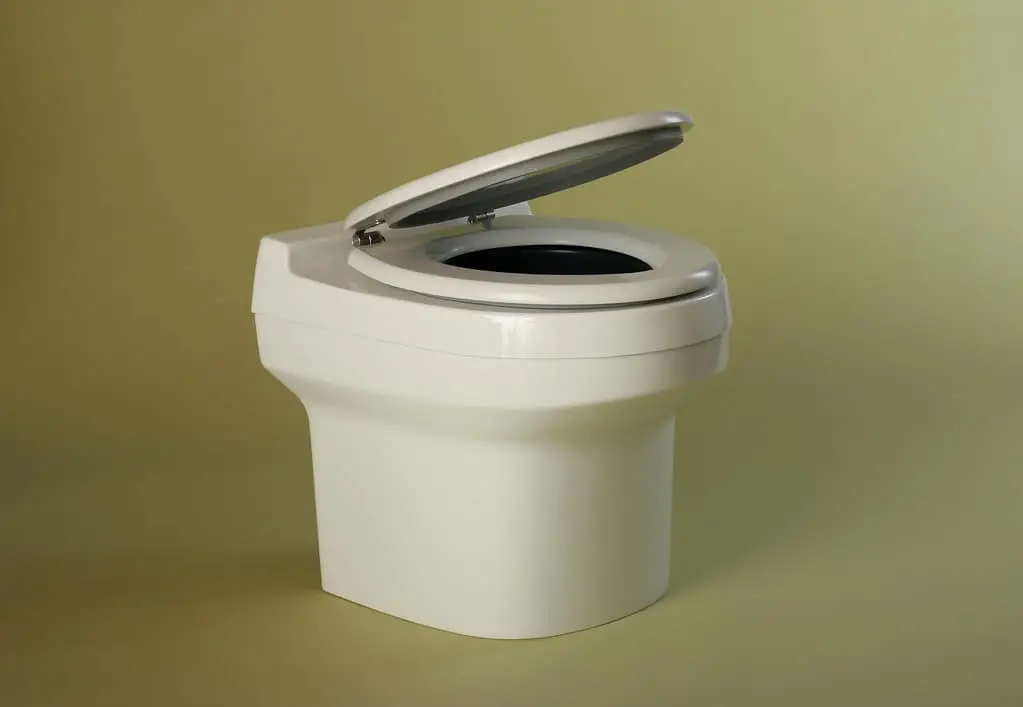Table of Contents
Standard options for outdoor bathroom use are limited to three choices — “roughing it,” port-a-potties, and outhouses. However, outdoor enthusiasts have an outstanding alternative to these. There is a cost-effective and eco-friendly option known as the composting toilet. This unique waste management system will suit your home and your outdoor, on the road lifestyle. With this option, there is no need for plumbing, septic, or sewer connection.
*This post may contain affiliate links. As an Amazon Associate we earn from qualifying purchases.
The composting toilet has been praised as a sanitary revolution in waste management.
What Is a Composting Toilet?
A composting toilet has all the basic features of a normal toilet with some added benefits. It differs in that this toilet is an odor free, cost-effective, chemical free, flush free, and plumbing-free solution. Through all natural processes, the waste you release into the bowl is converted into a soil-enriching fertilizer. Just like the name suggests, the toilet composts your feces. Imagine a miniature ecosystem for waste conversion. You’ll be using natural elements and processes like oxygen, moisture, heat, bacteria, and evaporation.
Is There a Need for a Composting Toilet?
Everyone with water free and/or outdoor bathroom needs to have only a few resources available. Port-o-lets are gross and reek, especially in hot weather. Outhouses are even more inferior. For RV operators, there is not an infinite amount of capacity in your sewage containers. In some areas and situations, there is nothing to turn to when the need for bathroom facilities arise. Others are anxious about their personal impact on the environment.
Traditional options result in a hazardous, polluted mess. RV and camper units have to give up footage and overall weight due to the plumbing set up. Some people wrestle with money concerns.
The benefits of a composting toilet for waste removal can’t be overstated. Whether at home or on an outdoor adventure, you can eliminate the most essential concerns of bathroom use:
- Energy concerns and plumbing availability
- Pollution
- Dumping concerns
- Space concerns
- Clean air
- Budget matters
Energy and plumbing are problems you’ll face when designing a bathroom. In low water situations where water conservation is costly or otherwise forbidding (for example, those in the high desert or drought conditions) using water for waste disposal will not be a concern for you. Even if saving water isn’t on your mind, there is the plumbing aspect you can cut out. With this cool system, you won’t need to worry about having water connections or a sewage tank.
For areas where there is no plumbing available, a composting toilet is the answer for all the above mentioned concerns. Those in an off-the-grid or outdoor setting, plumbing is not a luxury available to you. Primitive campers will really appreciate this special convenience of home that would otherwise mean a primitive option.
Disposal is safe and easy. Head to the compost pile and it is ready to go in. Even many campgrounds have compost piles available for visitors’ use. If a compost pile is not available, the solids can be removed into bags and dumped in the garbage. Boaters and fishermen can take the compost the legally establish distance offshore and dispose of it overboard. For the liquids, simply dilute and put it on the ground, pour it into the sewer, or (for boaters/fishermen) pour it overboard.
Composting toilets are great as a home setup and it pays off just as substantially with your “home away from home,” like RV traveling and camping. You also don’t need to concern yourself with adding pollution or making a carbon footprint on your surroundings. One of the amazing benefits of this invention is that the only thing you leave behind is healthier dirt.
There’s the space-saving matter to consider. Considering the case of plumbing a house, there are so many parts to work with. Your whole layout has to be designed with the pipe network in mind. That is not a worry with the compost system. Let’s imagine using this kind of toilet for your RV or camper. The infamous black tank is out of your life forever. Now that the black tank has gone away, you can create extra storage for hauling your gear or set up a tank to carry fresh water. For those DIY auto mechanics, you can install many other things where the septic used to be. There are lots of choices that were not available before.
These toilets can otherwise save you cash. First, it is an economical option even in comparison with the plumbing based option. If there are no public utilities in a given area, there’s the cost involved with installing a new septic tank which can swell to $10,000. For a fraction of that cost, you can get a compost toilet. A couple of septic issues like repairing a leach field or replacing laterals can cost more than a brand new composting toilet system. That is even before factoring for water costs (which we’ve already discussed.)
So even taking out of the equation outdoors living and recreation, the price of sewage is staggering. The same goes for monthly utility costs. Even a small family can rack up quite a bill. Given these comparisons, compost toilet systems are cost-effective above any other option. In an RV or camper with the removal of the black tank, you have just lessened the overall bulk/space usage of your unit.
How Does a Composting Toilet Work?
The basic setup of the composting toilet starts off much like any standard commode. You have an up-down adjustable seat with a bowl. Here is where the composting toilet separates itself from the ordinary. From the bowl, waste is sent into a trap door. Here, there is a bulking material which is mixed with the solids. This section is called the waste inlet port, located toward the top of the inner drum. The mixture is then emptied into the lower tank (the compost area).
Upgraded models use a separate composting drawer. With this, composting is completed in the separate drawer without contamination by the addition of waste. The compost in this drawer is dried until it is ready for removal. The liquids are channeled into the front tank. This function cuts out the smell because it prevents the chemical reaction that comes from mixing of the two wastes, which we will discuss in more detail later. When the compost drawer or collection chamber is filled, the removable tray comes out and the contents are recycled or trashed.
Imagine all the construction, heavy hauling, and running water pipes with your ordinary indoor plumbing job. Installing a composting toilet is a cinch. As mentioned before, this setup involves no plumbing. There are two simple parts with this unit. A small fan and a vent hose that runs outside.
There are some essential processes at play with composting toilets. Here are the details on that how that fleshes out.
Oxygen supply
Oxygen is the main component that lets aerobic bacteria to break down human waste and toilet paper quickly and without the nasty odor. A composting toilet keeps this supply at the correct level to facilitate the breakdown of waste.
Moisture control
The next basic ingredient for the composting process is adequate moisture. The best balance is between 40 percent and 60 percent moisture content. Above or below this optimal range and the breakdown process is hampered. Below 40 percent and the process will stop completely. Above 60 percent, oxygenation is thrown off. These toilets are engineered to create this perfect composting environment.
Keeping warmth correctly maintained
As the materials are breaking down, heat is generated. This inner drum helps to hold in and stabilize this heat. Some models have a base heater installed.
Aerobic bacteria makes the process odorless
When oxygen and moisture are in the correct balance, organic material is broken down free of the bad smell. This material is converted into water and carbon dioxide which leaves behind simple salts. The end product is an excellent plant food.
Evaporation process
Much of the waste is taken away by the venting system, as mentioned above, where the liquids evaporate out of the system. This accounts for 90 percent of the composting process. A bulking material is combined with solids to begin the composition process. This is then put in the containment unit where the environment is a balanced blend of moisture, temperature, and gases. This removes pathogens and viruses creating a proper compost, ready for use.
Go Green!
Toileting issues, especially outdoor toileting issues, are an age-old problem. Despite the advent of modern devices and government run utilities, there are headaches. The costs and dirty work involved in evacuating sewage tanks are forbidding. Waterways are dirtied up by careless human waste disposal. Campgrounds sewers quickly get overwhelmed with campers’ deposits.
Composting toilets have provided, to date, the most effective and innovative solution of the problem. Anyone with green (money) or green (eco-system) concerns have the best fix possible. This is especially a dream come true for your campsite and RV setup. Overall, the return on investment is incredible.
Featured Image: CC BY 2.0, by SusanA Secretariat, via Flickr

